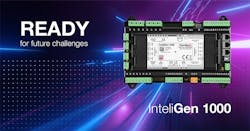The Emerging Challenges for the Data Center Industry in the Age of AI
Artificial intelligence has seen a meteoric rise in popularity over the last few years, but what we have seen so far is nothing compared to what we will witness in the years to come. The increasing demand for more powerful AI brings with it significantly higher requirements for data processing and storage capabilities, pushing data centers to their operational limits. To accommodate the inevitable and seismic advancements of AI, data centers must evolve to meet the growing demand. To successfully achieve this, the data center industry must first address several key challenges.
Scalability requirements
Increasing the scale of data centers isn’t as straightforward as implementing more servers. For data centers to sufficiently handle the constantly increasing demands of AI, it is necessary for facilities to safely scale their operations proportionately to meet the increased demand requirements for power, cooling and infrastructure.
To accomplish this, facilities require a control system that is capable of managing multiple sources of power, such as gensets, renewable energy sources and battery storage systems. These power sources should be managed via a single controller connected over a CAN line that enables all sources to be managed simultaneously. This solution would ensure that data centers can efficiently implement additional power sources and scale their facilities without putting their operations at risk.
Complexity requirements
The larger a data center expands in size and capacity, the more components there are to work with, increasing the likelihood of possible points of failure. To ensure operational efficiency and safety, it is vital that each of these components works in harmony with the rest of the system. This can be significantly complex to manage.
To overcome this complexity, it is essential for data centers to have an advanced control system that can monitor and manage these components simultaneously. This requires a control system capable of processing substantial amounts of information on every relevant topology in real-time. For example, by using a Programmable Logic Controller (PLC), data centers can easily identify and respond appropriately to all known scenarios within their system.
Consumption requirements
AI’s rapid rise in popularity has resulted in considerably higher consumption requirements, largely due to the power used in training AI models. Wells Fargo predicts that the consumption demand for AI power could surge as much as 550% by 2026. In addition to putting strain on the power demands of data centers, the increase in consumption demands has contributed to higher operational costs and regulations from electricity providers to set limits on consumption and prevent disruptions to the grid. This creates a challenge in which data centers must find a way to meet their power demands without surpassing grid limits.
One of the best solutions to overcoming this challenge is through the implementation of distributed energy resources (DERs), such as gensets, renewables and battery energy storage systems, into the data center’s infrastructure to reduce strain and dependency on the grid while meeting the center’s demands. The most practical way to achieve this is through the use of a controller that can seamlessly integrate and manage multiple DERs at once while ensuring adherence to grid codes.
Meeting sustainability goals
Many of the companies committed to advancing artificial intelligence, such as Amazon and Microsoft, have also set ambitious sustainability goals. Microsoft, for example, has pledged to be carbon negative by 2030, while their work on AI has accelerated substantially. This means that many companies now face the challenge of requiring more processing power to meet power demands while also seeking to reduce their carbon emissions.
The most obvious answer to this challenge is the implementation of renewable energy sources, such as photovoltaics (PV) and battery storage into data center operations. By incorporating more renewable sources of energy, data centers can increase the power generated for operations while reducing their use of fossil fuels. To achieve this, facilities would require an energy management controller capable of simultaneously monitoring and managing both renewable and non-renewable power sources.
Reliability
Reliability is a key concern. In addition to the challenges mentioned, data centers must fundamentally maintain the highest level of reliability. These facilities need to ensure that, even when scaled, their data centers can sustain the reliability of their critical infrastructure.
This requires a resilient control and communication solution that employs Hot-swap redundancy and CAN bus redundancy. These redundancies ensure that, in the event of a controller or CAN failure, both control and communication lines remain operational, and that solution downtime is minimised.
About the Author

Pavel Durst
Pavel Durst works as a Global Accounts & Business Development Manager for large global customers of ComAp. With deep expertise in control systems and a strong focus on innovation, Pavel navigates ComAp’s customers towards resilient and sustainable solutions for data centers and critical infrastructure.
ComAp is a global leader in smart control solutions for power generation and energy management, empowering the world’s transition to sustainable energy. With its presence in the control solution market for more than three decades, ComAp is a reliable partner for resilient and scalable solutions for critical power applications.



